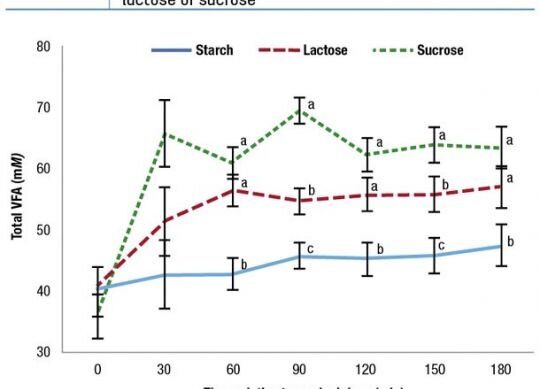Specific sugar types and sources for dairy cows
Today’s dairy farms typically feed a large amount of fermented forages and processed feeds which contain little sugar. Because of this, lactating dairy rations usually contain about 1.5% to 3% sugar, if no supplemental sugar is fed. Since sugars are generally rapidly digestible, they can help the rumen microbes capture and use nitrogen. Supplemental sugars can improve rumen pH. When more sugars are incorporated into the rumen bacteria, less organic matter is converted into fermentation acids. Furthermore, dietary sugar often increases the molar proportion of butyrate, which yields only one hydrogen ion while propionate and acetate generate two hydrogen ions. Butyrate also stimulates the rumen epithelial cells, increasing volatile fatty acid (VFA) absorption from the rumen.
Added sugar often increases milkfat percentage and/or milkfat yield. This may be because butyrate generated from sugar is used for milkfat synthesis. Also, if sugars moderate rumen pH, one would expect an improvement in milkfat percentage. Finally, sugars may promote the normal fatty acid biohydrogenation pathway, decreasing the amount of the trans-10 isomer of the 18:1 fatty acid implicated in milkfat depression.
In a recent analysis of published research, it was found that supplemental dietary sugar from molasses, whey or dry sugar increased yield of milk, 3.5% fat-corrected milk and milk true protein. Fat-corrected milk (3.5% FCM) increased from 71.2 to 74.4 pounds per cow per day with 5% to 7% added dietary sugar. Higher-producing cows had greater responses to added dietary sugar. Cows producing more than 73 pounds per day of milk produced 4.7 pounds per day more 3.5% FCM with 5% to 7% added dietary sugar. However, cows producing less than 73 pounds per day only responded with 1.7 pounds per day more 3.5% FCM.
It was recommended that dairy producers consider supplementing sugar in lactating dairy diets to achieve 6% to 8% diet sugar for optimum rumen function and performance. This would generally require 1.5 to 2 pounds of supplemental sugar per cow per day. Suggested optimal ranges (percent DM) for other nutrients include starch at 22% to 27%, soluble fiber at 6% to 8% and rumen-degradable protein (RDP) at 10% to 11%.
Common sources of supplemental sugar are (with percentage sugar on a DM basis): table sugar (100%), molasses (70%), whey (70%), candy (40%), chocolate (35%), almond hulls (30%), citrus pulp (25%), cookie (22%) and beet pulp (15%). Liquid sugar sources have the added benefit of reducing TMR sorting. Cost and availability of sugars varies greatly by region.
Types of sugar include monosaccharides (glucose, galactose and fructose) as well as disaccharides (sucrose, maltose and lactose). Monosaccharides have one sugar molecule, while disaccharides have two sugar molecules bonded together. Sucrose (table sugar) contains glucose and fructose. Cane molasses contains mainly sucrose, glucose and fructose. Lactose (milk sugar) contains glucose and galactose. Fruits and grains often contain maltose. Digestion rates (percent per hour) differ among sugars. Danish researchers estimated the following rates of digestion for sugars: sucrose (1,300% per hour), glucose (521% per hour), fructose (530% per hour), galactose (439% per hour) and lactose (331% per hour). Starches are digested at 10% and 30% per hour.
When Canadian scientists dosed rumen-cannulated cows with either sucrose, lactose or cornstarch, sucrose fermented more quickly than lactose, followed by cornstarch. When either sucrose or lactose was substituted for starch in lactating cow diets (9% dietary sugar), both sugar sources similarly improved milk as well as milk component yields. Although lactose was digested at a slower rate than sucrose, cows still responded to lactose’s much higher rate of digestion versus starch.
Silages contain little of the sugar originally found in the harvested forage, but silages do contain some residual sugars from the breakdown of hemicelluloses in fiber. These five-carbon (pentose) sugars, including xylose, mannose and arabinose, have a much slower rate of fermentation than common supplemental six-carbon (hexose) sugars (glucose, fructose and galactose). Research at Cornell University found that rumen bacteria had slower growth on five-carbon sugars compared to six-carbon sugars. Sugar alcohols include sorbitol and glycerol (a biodiesel byproduct). Unlike sugars, sugar alcohols are fermented primarily to propionate. Sugar alcohols can be used as a partial, alternative energy source for dairy cows and may also improve glucose status in transition cows.
Alternative energy sources should always be given consideration to save feed costs. However, productive benefits of supplemental sugars may justify a higher cost per ton or per unit of energy.
Adapted from Mary Beth de Ondarza for Progressive Dairy.



